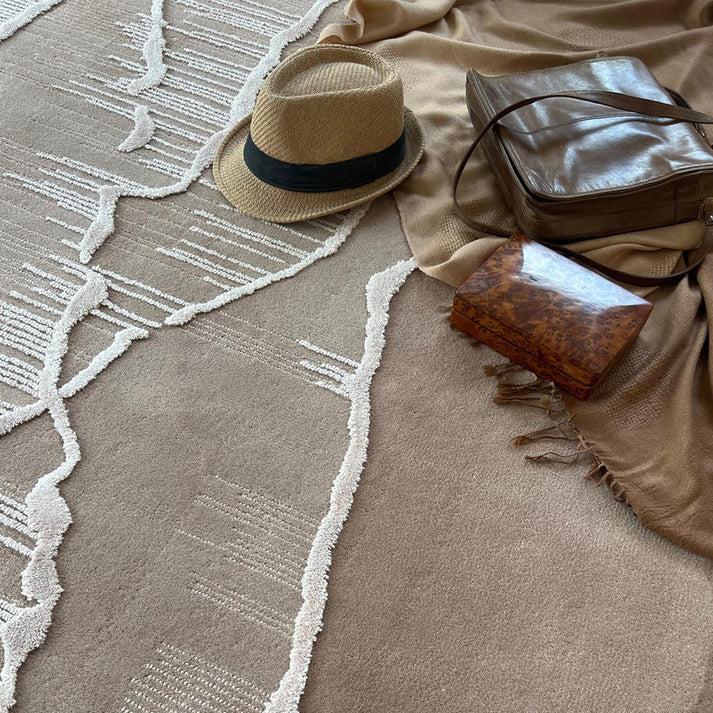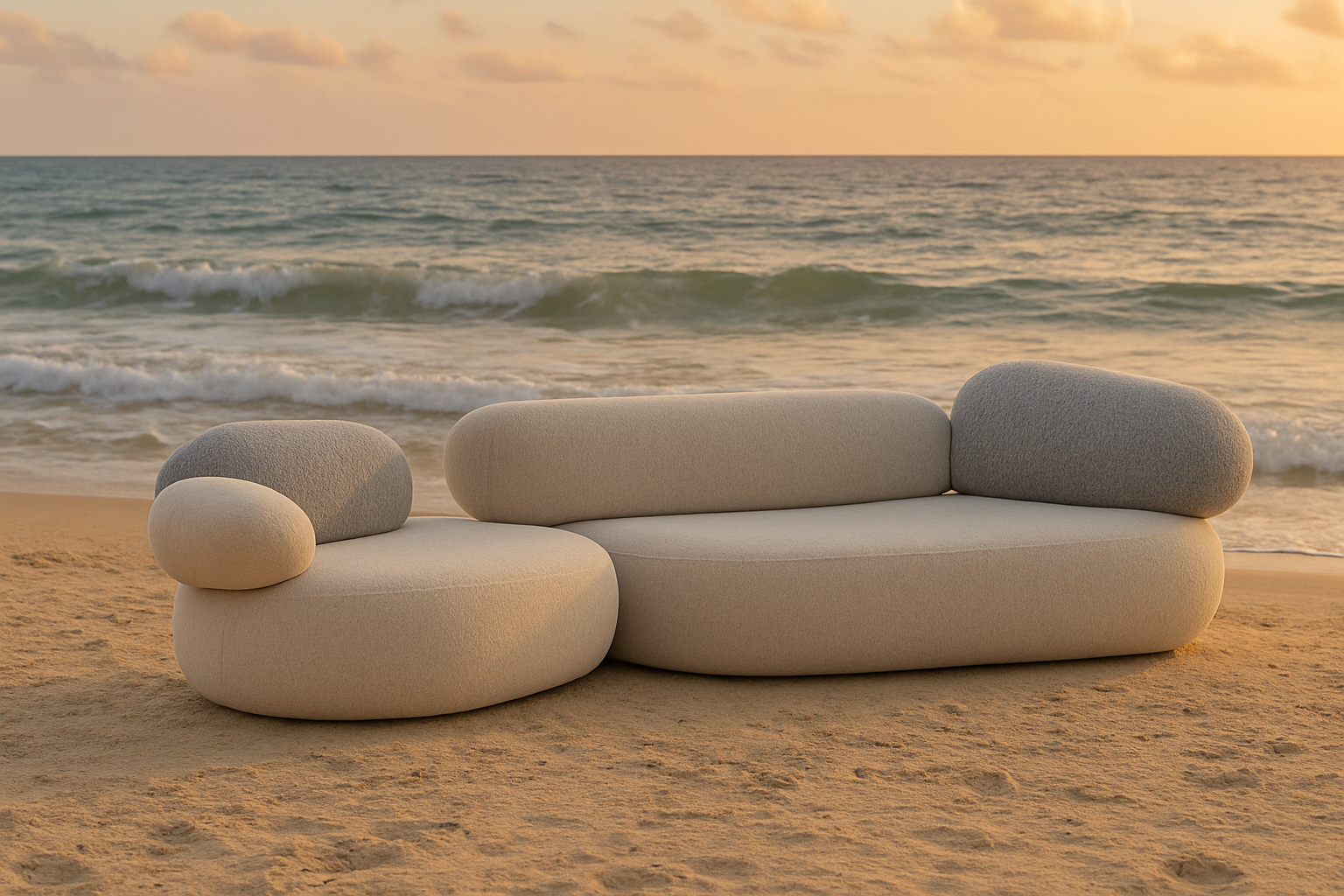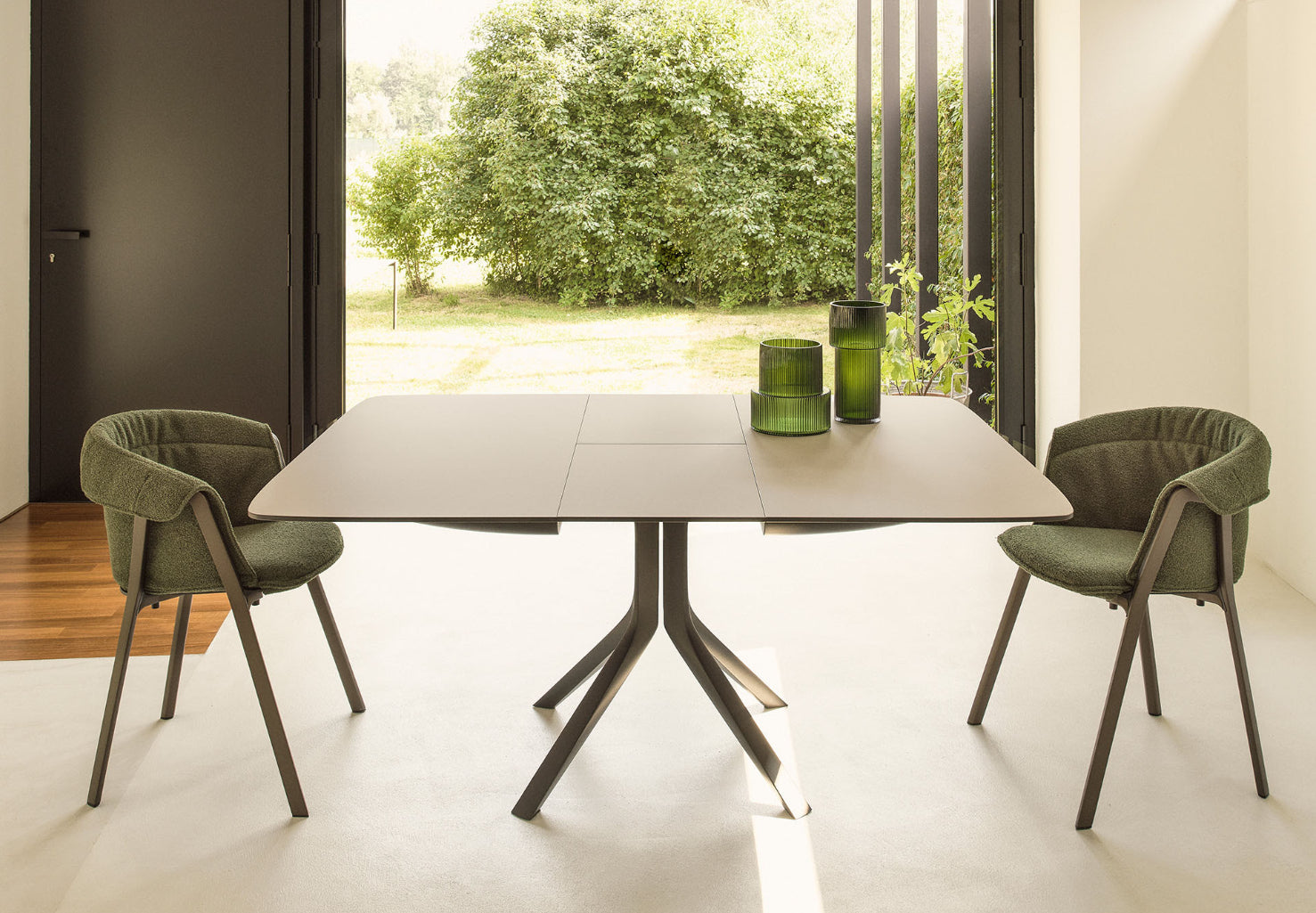
Luxury Area Rugs: How to Tell If a Rug Is Good Quality
There’s a particular kind of quiet that settles in a room once the right rug is in place. Footsteps soften. Sound finds a rhythm. Light spills across the floor differently - diffused, anchored, complete.
In a space filled with glass, steel, or stone, the addition of a high-quality rug does more than finish the look. It balances the energy. It offers comfort without drawing attention. It becomes part of the room’s structure, not just its styling.
As Architectural Digest notes,
“Just as a house wouldn’t be a home without art on the walls or statement lights casting a warm glow, it wouldn’t feel right without rugs underfoot.”
But for all their impact, luxury rugs can be difficult to assess. Two options might look nearly identical on the surface, yet perform entirely differently in real life. One will age beautifully, softening with time; the other will show wear within months.
The difference comes down to a handful of essential qualities: what it’s made of, how it’s constructed, and how it responds to light, touch, and time. In this guide, we’re outlining how you can tell the difference between rugs while you shop and why it matters to buy high-quality rugs.
Which Rug Fibers Are Better - Natural or Synthetic?
What you walk on matters more than what you walk past.
The first way to judge a rug’s quality is by looking at its fiber. In luxury design, this isn’t just a material choice; it’s a tactile decision that affects how a space feels, ages, and functions under daily use.
Natural Fibers
Natural fibers - wool, silk, and cotton are the materials of choice for rugs that are meant to last. They offer not only comfort but depth: of tone, of texture, and temperature. Wool, especially, brings a softness that’s firm but yielding, like stepping into memory. It absorbs dye evenly, making colors richer and more dimensional, and it retains resilience after years of use.
-
Wool
In high-end interiors, wool remains the primary choice for luxury rugs. Clients who live with wool rugs in their living rooms or dining areas often describe the same experience: warmth underfoot that never feels heavy, and colors that shift subtly over time, rather than fading. Rugs made from New Zealand wool, like those in our handmade rugs collection, retain their integrity over time, even under furniture. -
Silk
Silk, by contrast, adds refinement. It doesn’t compete with wool but enhances it, creating contrast within patterns, offering a soft sheen that catches light in ways wool never can. You’ll often find silk blended into rugs as a secondary fiber, especially in geometric or gradient designs, where the interplay between matte and luminous is part of the appeal. -
Cotton
Cotton rarely appears on the surface of a luxury rug but plays a foundational role in the structure. It brings flexibility and form without adding weight or stiffness, and when used in the warp or backing, it supports the integrity of the rug as a whole.
Bestselling High end Rugs made from Natural Fibers from Our Collection:
-
Morning Mist Flat-Weave Rug: Made from New Zealand wool, this flat-weave rug captures the vibrancy of wildflowers in morning light. It’s a visual poem in fiber - lightweight, breathable, and rich in color depth.
-
Monu Hand-Knotted Rug: Crafted from a luxurious blend of New Zealand wool and viscose, Monu showcases the subtle interplay of matte and sheen. The hand-knotting ensures heirloom-level durability.
-
Eternal Eye Area Rug: A sculptural piece made from undyed New Zealand wool and organic cotton. Its rounded shape and fringe detailing highlight the tactile beauty of natural materials.

Synthetic Fibers
There is a place for synthetic fibers, particularly viscose and polyester, but their strengths are narrow. These materials can deliver sheen, softness, and visual drama in the short term, but they tend to break down faster, especially under friction or the sun. That doesn’t mean they should be dismissed, but in high-traffic rooms, they demand a degree of care that doesn’t always align with how we live.
In mood-driven spaces - a formal sitting room, a private study, a guest suite- viscose-based rugs can offer elegance without the expectation of longevity. But where movement is frequent, wool will almost always outperform.
Bestselling Synthetic Fiber Rugs from Our Collection:
-
Lucens Handloomed Rug - Crafted from viscose, Lucens catches light like a shallow pool - bright at the edges, darker toward the center. We often recommend this for low-traffic reading rooms or interior zones designed around atmosphere rather than activity.
-
Fuller Loom-Knotted Rug - A 50/50 blend of viscose and wool, Fuller delivers a silky finish with a soft hand. Its loom-knotted construction adds density and elegance - ideal for low-traffic luxe zones.
Tip: For high-traffic areas, wool is almost always the safest choice for long-term durability.
What to Keep in Mind
-
Wool offers structure and resilience - ideal for living rooms, dining spaces, and entry zones.
-
Silk heightens contrast and detail - best used in moderation or low-use areas.
-
Viscose/poly blends work best in ambient, protected rooms where visual impact matters most.
-
Cotton supports, rather than surfaces - look for it in the foundation or backing.
Fiber is not just a material; it’s a performance strategy. Choose based on how the room is used, not just how it looks.
Is the rug constructed hand-knotted, hand-tufted, or machine-made?
A good rug begins before a single thread appears on the surface.
The second marker of quality is construction. Not all rugs are built the same - even if their patterns are similar or their piles look plush at first glance. The method used to create a rug affects everything: its density, its feel underfoot, how well it ages, and how easily it can be cleaned or repaired over time.
Hand-Knotted
Hand-knotted rugs are the benchmark. Each knot is tied individually, a process that can take months, even for a medium-sized piece. The result is a rug that feels dense, intentional, and enduring. Patterns are woven, not printed or glued, and the back of the rug shows a clear mirror image of the front - slightly muted, but just as precise.
Because they’re free of latex or fabric backing, hand-knotted rugs breathe better and adjust to the room’s temperature and humidity. They also tend to get better with age. We’ve seen well-maintained hand-knotted rugs in client homes continue to look refined a decade later, with only subtle softening of edge or tone. Boutique rugs from brands such as Volver Studios are excellent examples of modern design combined with traditional hand-knotting.
Hand-Tufted
Hand-tufted rugs offer a different kind of quality. They’re faster to make and less intricate in construction, but that doesn’t mean they lack value. When tufted with high-quality wool and backed with natural latex, these rugs offer softness and color at a price and timeline that make sense for many homes.
They’re ideal for private rooms such as bedrooms, studies, and dressing areas where comfort and visual warmth are the priorities. Unlike knotted rugs, the back is covered with fabric, and you may feel a light stiffness from the adhesive base. Expect a lifespan of 5-10 years with consistent care.
Best-selling Handmade Rugs From our Collection -
1. Wall Patina Rug - Hand-tufted in a sumptuous blend of premium wool and tencel, this high-density rug channels the layered beauty of aged plaster. Its painterly patina reads like a bespoke work of art - soft underfoot yet remarkably resilient, built to elevate transitional interiors with heirloom-grade appeal.
2. Sand Handtufted Rug - Crafted from 80% New Zealand wool, 20% Bamboo Silk, and hand-tufted to a plush, even pile, Sand exudes refined minimalism. The sun-washed neutral hue and precise tuft density offer both serene elegance and lasting durability, making it an ideal foundation for calm, curated spaces.
3. Ruter Mint Chocolate Rug - An artisanal reinterpretation of classic tweed, Ruter is hand-tufted in 80% New Zealand wool and 20% bamboo silk. Its irregular checkerboard of mint, aubergine, and cocoa sits on a sculpted 13 mm pile - vivid in color, sumptuous in feel, and worthy of a bespoke setting.
Tufted rugs can still be luxurious, especially when made from high-quality wool. They’re a great choice for low- to medium-traffic areas like bedrooms or offices.
Machine-Made
Machine-made rugs have their place, but it’s not in longevity. They’re efficient, precise, and consistent, but often lack the texture variation, resilience, and tactile richness that define luxury. The difference becomes apparent over time: the pile flattens, the color dulls, and wear shows in the backing first.
In fast-turnaround homes or spaces that change with seasons, they serve a purpose. But they don’t carry the weight of presence that handmade rugs offer.
How to tell the difference at a glance
-
Flip the rug over. A hand-knotted rug will show an identical version of the pattern on the back - slightly more muted, but with clear definition and no fabric backing.
-
Look for glue or latex. If the back is stiff or smells like adhesive, you’re likely looking at a tufted or machine-made rug.
-
Check the edge and fringe. True hand-knotted rugs have fringe that continues from the body of the rug; it’s part of the warp, not sewn or glued on.
Have You Done the Weight and Density Test?
The way a rug feels underfoot tells you more than any label can. In high-traffic areas like living rooms or under dining tables, the difference between a rug that lasts and one that flattens comes down to two key qualities: weight and density.
These aren’t just technical terms; they impact everything from comfort to how a rug will age in your space.
Why Density Matters in Real Homes
High-density rugs have more yarn packed into every square inch. This creates a firm, resilient pile that springs back after pressure, holds pattern definition, and ages with structure.
By contrast, lower-density rugs may look full on the surface, but over time the pile compresses, fibers spread, and backing becomes visible. These rugs wear out faster and feel less substantial under furniture.
How to Perform a Quick In-Person Density Test on a Luxury Rug
You don’t need special tools, just a few tactile checks:
-
Lift a corner. A well-constructed wool rug will feel balanced and weighty for its size. If it feels unusually stiff or overly heavy, it could be due to filler or excess glue rather than actual fiber density.
-
Press into the pile. With an open palm, apply firm pressure. Then release.
Does the rug spring back into place? That bounce-back tells you the pile is both resilient and tightly packed. If your handprint lingers, it may compress more with use. -
Part the fibers. Gently spread the pile with your fingers and check how easily you see the base or backing. In a dense rug, you'll see very little. If the foundation is immediately visible, it’s a sign of looser construction - less ideal for areas with frequent foot traffic.
Pro Tip: Not All Weight Is Good Weight
In machine-made or tufted rugs, heaviness can be misleading. It often comes from adhesives, secondary backings, or added fillers, not from fiber content. These rugs may feel firm initially, but lose structure over time.
In contrast, hand-knotted wool rugs are naturally dense without relying on glues. Their weight comes from compact, tight weaving, not additives, making them more breathable, repairable, and long-wearing.
These checks are especially important for living room area rugs, which take on heavy foot traffic and the weight of furniture.
Will the rug’s color hold up over time?
Color, in a luxury rug, is more than a hue; it’s an atmosphere. It catches the morning light, softens shadows in the afternoon, and carries the weight of the room’s mood after dark. Whether your space calls for grounded earth tones or tonal minimalism, how a rug holds color over time determines not only how it looks, but how it lives.
Color retention in luxury rugs isn’t just about aesthetics; it’s about chemistry, structure, and finishing. Understanding this makes all the difference in high-exposure interiors where natural light, foot traffic, and cleaning cycles become part of a rug’s environment.
What determines lasting color?
-
Fiber: Wool is the preferred canvas in luxury weaving. It absorbs dye into the core of the fiber, not just on the surface, resulting in even, saturated tones that age gracefully. Silk behaves differently because it reflects light, it adds sheen and contrast, especially in patterned rugs, but is more prone to highlighting changes in pile direction or light source. Viscose, often used in machine-made or blended rugs, offers initial brilliance but lacks long-term resilience.
-
Dye chemistry: High-end rugs use chrome or acid dyes - professional-grade solutions that chemically bond with the fiber, ensuring deeper, more stable coloration. In contrast, cheaper rugs often use surface-level dyeing, which may result in uneven fading or color migration after cleaning.
-
Finishing technique: Once dyed, luxury rugs undergo a rigorous rinsing and heat-setting process that locks pigment into the fiber. If this step is rushed or skipped, residual dye can sit on the surface, vulnerable to wear, moisture, or sunlight.
Three quick ways to check color integrity
You don’t need lab testing; these simple techniques can tell you everything you need to know:
-
The rub test: Dampen a clean white cloth and press it gently into a discreet corner of the rug. A faint tint might be normal, especially in deeply saturated tones like indigo or crimson. But heavy dye transfer? That’s a red flag.
-
The part test: Use your fingers to part the pile and check for consistency from tip to base. High-quality rugs will show even coloration. A pale or grayish core can signal a surface-only dye that may wear unevenly.
-
The daylight test. View the rug in natural light, preferably near a window. Uneven tone, dull patches, or chalky finishes suggest over-bleaching, poor fiber, or shortcut dyeing.
Long-term color care in real spaces
Even the best dye work benefits from a few practical care habits:
-
Rotate the rug every few months so that one side doesn’t bear all the sunlight.
-
Use a felt rug pad to subtly lift the fibers and support airflow after cleanings.
-
Blot spills with cool water before applying anything stronger - avoid alkaline cleaners, which can lift even well-set dye.
We've tested high-density wool rugs in coastal homes with large southern-facing windows. Those with felt pads and regular rotation retained color integrity 2–3 years longer than unpadded or static rugs, especially in lighter tones.
Do a rug inspection: Look at these 5 Key Details
While color and material tend to draw the eye first, the quality of a rug often lives in its quieter details - the way it’s edged, backed, and labeled. These final touches speak to both longevity and craftsmanship.
Before you finalize a choice, inspect the following:
-
Edges
Edges are where daily life meets the rug - vacuums, shoes, chairs in motion. In quality rugs, the edge is finished with hand-applied serging or a tight overcast stitch that runs the perimeter with clean tension. It should feel integrated, never decorative or fragile. In flatweaves, look for neatly executed binding; corners should be crisp and without bunching or bowing.
-
Fringe
In hand-knotted rugs, fringe is not ornamental; it’s structural. It represents the warp threads, woven through the body of the rug and extended at either end. These pieces tell you the rug was made by hand, knot by knot.
When fringe is sewn or glued on, it’s decorative and often used to simulate the look of a hand-knotted rug on a tufted or machine-made base.
-
Backing
Flip the rug.
-
Hand-knotted rugs will show the full pattern on the back, just slightly muted. There’s no glue, no mesh, only rows of knots and clear weft lines.
-
Hand-tufted rugs often have a canvas or cotton cloth backing applied with latex. In high-quality versions, this feels flexible, not stiff or overly coated.
-
Machine-made rugs are typically uniform on the back, often with printed patterns and synthetic reinforcement.
Red flags: hard, glossy areas on the underside, pooled adhesives, or a strong chemical odor - these point to rushed production and unstable materials.
-
Adhesive
Quality tufted rugs use natural latex - supple, flexible, and subtly grippy. Lower-end rugs rely on synthetic adhesives, which can stiffen, crack, or crumble over time. Gently flex a section of the rug. If you feel resistance or hear a brittle crackle, it may contain hardened filler or aging glue.
5. Labeling in Boutique Rugs
A proper label on a luxury rug should include:
-
Pile fiber (e.g., 80% New Zealand wool, 20% silk)
-
Foundation fiber (if different)
-
Country of origin
-
Basic care guidance
Boutique rugs may also include the name of the design, the region where it was woven, or the production batch - small details that support authenticity and add value when cleaning or appraising.
Two-minute in-store inspection checklist:
-
Run your fingers along the edge from corner to corner - feel for uniform stitching and tension.
-
Flip one corner - does the back confirm the construction method?
-
Snap a photo of the label or any attached documentation. Keep it on file for future reference or maintenance.
Common Misconceptions About Luxury Rugs
-
Heavier is better
Weight can be misleading. A rug’s heft may come from dense adhesive, not dense fiber. What matters more is how compact the construction is - a tightly woven wool rug with short, springy pile often outperforms a heavier tufted one in both feel and longevity. -
All wool performs the same
Wool quality varies dramatically based on where it's sourced and how it's prepared. New Zealand and Tibetan Highland wool are prized for their long fibers, fine crimp, and ability to absorb dye deeply. Lower-grade wool may flatten quickly, shed excessively, or absorb stains more readily. -
Tufted rugs are not luxurious
They can be, when crafted with care. A hand-tufted rug made from long-staple wool, bound with natural latex, and hand-finished offers plush comfort and strong color. They’re best suited to lower-traffic rooms or spaces where you want softness without the commitment of hand-knotting. -
Machine-made looks the same, so it is equal
Machine-made rugs can closely mimic the patterns of hand-knotted pieces, but the difference reveals itself over time. Hand-knotted rugs develop character, respond to professional cleaning, and can be re-fringed or re-edged. Machine-made designs flatten and fade more quickly, and repairs are rarely successful.

Five questions to ask before you buy
-
What is the exact fiber mix and source?
Ask for specifics like New Zealand wool or silk percentage. Clarify why any synthetics are included. -
How is it constructed?
Hand knotted, hand tufted, or machine-made. Confirm by examining the back and the fringe. -
How does it feel underfoot?
Ask for pile height, face weight, and density if shopping online. In person, stand on it in soft shoes or barefoot. -
How were the dyes set and tested?
Look for lightfast or UV-stable dyes, especially for sunlit rooms. -
How are the edges and backing finished?
Tight serging, integrated fringe, and a clean backing indicate higher standards.
Final Thoughts
Luxury lives in the tactile - the soft compression beneath bare feet, the quiet hush a rug brings to open space, the slight sheen of wool catching late afternoon light. A good rug doesn’t rush to announce itself. It settles into the room, creating warmth and rhythm over time.
The best ones aren’t just styled, they’re built. They endure years of footsteps and conversation, furniture weight, and morning sun. They’re not accessories. They’re anchors.
So next time you step into a showroom, flip a corner, part the pile, and feel for spring. Because in the best rugs, quality isn’t hidden, it’s woven in.
Frequently Asked Questions about Living Room Area Rugs
Q: What makes a rug look cheap?
Overly shiny, slippery fibers and printed-looking patterns are quick giveaways. Thin pile that crushes underfoot, fraying edges, or a fringe that’s obviously sewn on also signal shortcuts. If a damp white cloth picks up color or the backing smells strongly of glue, it won’t age like a luxury piece.
Q: How do I identify an expensive rug?
Flip it: a hand-knotted rug shows the pattern clearly on the back with visible knots, not fabric or latex. Expect dense wool with optional silk accents, springy pile that rebounds, and tidy hand-serged edges with fringe that continues from the weave. Clear labeling of fiber and origin is another hallmark of quality.
Q: How can I tell if a rug is authentic?
Start with construction: hand-knotted pieces have visible knots and no secondary fabric backing. Fringe should be part of the warp, edges straight and tightly finished, and colors even from tip to base when you part the pile. Ask for documentation on fiber content and country of origin to confirm provenance.
Q: What is the best quality material for a rug?
Wool is the top choice for everyday luxury because it is resilient, naturally stain-resistant, and comfortable underfoot. Silk adds luminous detail in low-traffic rooms or as accents within a wool ground. Cotton works well in the foundation for stability, while synthetics are practical in spill-prone zones but rarely match wool’s longevity.



